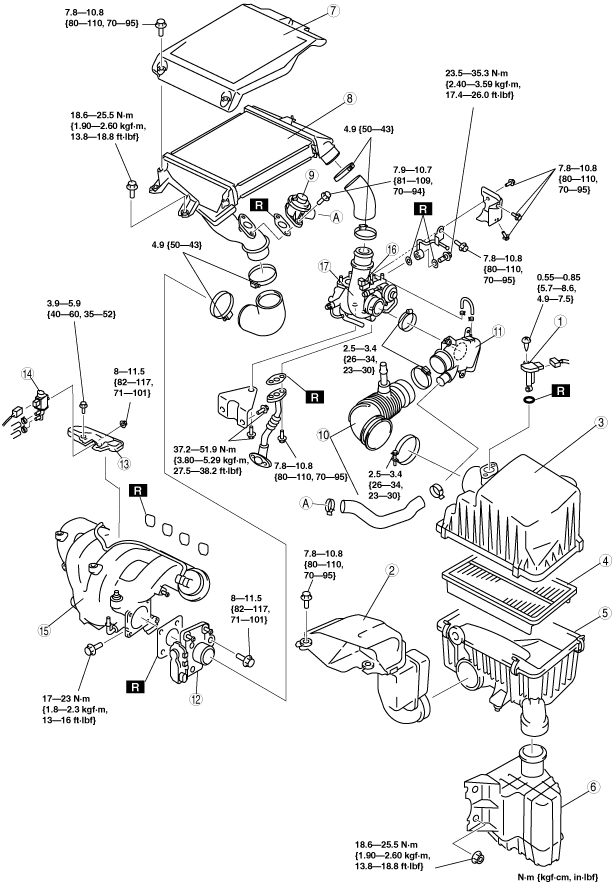 |
INTAKE-AIR SYSTEM REMOVAL/INSTALLATION [L3 Turbo]
id0113b5801900
1. Disconnect the negative battery cable. (See BATTERY REMOVAL/INSTALLATION [L3 Turbo].)
2. Remove the charge air cooler duct.
3. Remove the battery and battery tray. (See BATTERY REMOVAL/INSTALLATION [L3 Turbo].)
4. Remove the under cover.
5. Remove in the order indicated in the table.
6. Install in the reverse order of removal.
7. Complete the “AFTER REPAIR PROCEDURE”. (See AFTER SERVICE PRECAUTION [L3 Turbo].)
8. Add the engine coolant to the cooling system filler neck and the coolant reserve tank to replace that during servicing. (Turbocharger not removed)
9. Refill the engine coolant. (Turbocharger removed)
10. Inspect the engine coolant level. (See ENGINE COOLANT LEVEL INSPECTION [L3 Turbo].)
11. Inspect for engine coolant leakage. (See ENGINE COOLANT LEAKAGE INSPECTION [L3 Turbo].)
12. Perform the following procedure.
acxaaw00000875
|
|
1
|
MAF/IAT sensor
|
|
2
|
Fresh air duct
|
|
3
|
Air cleaner cover
|
|
4
|
Air cleaner element
|
|
5
|
Air cleaner case
|
|
6
|
Resonance chamber
(See Air Hose Removal Note.)
|
|
7
|
Charge air cooler cover
|
|
8
|
Charge air cooler
|
|
9
|
Air bypass valve
|
|
10
|
Air hose
(See Air Hose Removal Note.)
|
|
11
|
Air duct
(See Air Duct Removal Note.)
|
|
12
|
Throttle body
(See Throttle Body Removal Note.)
|
|
13
|
Vacuum chamber
|
|
14
|
Variable swirl solenoid valve
|
|
15
|
Intake manifold
(See Intake Manifold Removal Note.)
|
|
16
|
Wastegate control solenoid valve
|
|
17
|
Turbocharger
(See Turbocharger Removal Note.)
|
Resonance Chamber Removal Note
1. Remove the mudguard (LF).
2. Remove the resonance chamber.
Air Hose Removal Note
1. Disconnect the variable swirl shutter valve switch connector.
2. Disconnect the fuel injector harness connector.
3. Disconnect the ventilation hose connected to the air hose.
4. Remove the air hose.
Air Duct Removal Note
1. Disconnect the wastegate control solenoid valve connector.
2. Disconnect the purge solenoid valve connector.
3. Disconnect the EGR valve connector.
4. ATF gage pipe out of the way. (ATX)
5. Remove the air duct.
Throttle Body Removal Note
Turbocharger not removed
1. Disconnect the throttle body connector.
2. Wrap a clean cloth around the cooling system cap and release the pressure by loosening the cap slowly.
3. Remove the water hose from the throttle body and plug the water hose quickly.
4. Remove the throttle body.
Turbocharger removed
1. Disconnect the throttle body connector.
2. Drain the engine coolant before disconnect the water hose. (See ENGINE COOLANT REPLACEMENT [L3 Turbo].)
3. Remove the throttle body.
Intake Manifold Removal Note
1. Remove the fuel delivery pipe cover.
acxaaw00000876
|
2. Disconnect the quick connector connected to the intake manifold.
3. Remove the EGR pipe.
4. Disconnect the variable swirl solenoid valve connector.
5. Disconnect the OCV connector.
6. Disconnect the PSP switch connector.
7. Remove the oil level gauge pipe. (See OIL PAN REMOVAL/INSTALLATION [L3 Turbo].)
8. Remove the splash shield (RF).
9. Remove the drive belt. (See DRIVE BELT REMOVAL/INSTALLATION [L3 Turbo].)
10. Set the power steering oil pump out of the way.
11. Disconnect the fuel pressure sensor connector.
12. Disconnect the vacuum hose connected between the intake manifold and the master cylinder from the intake manifold.
13. Disconnect the MAP sensor connector.
14. Remove the intake manifold installation bolts.
15. Disconnect the evaporative hose connected between the intake manifold and the PCV valve from the intake manifold.
16. Remove the intake manifold.
Turbocharger Removal Note
1. Remove the middle pipe (See EXHAUST SYSTEM REMOVAL/INSTALLATION [L3 Turbo].)
2. Disconnect the HO2S connector.
3. Remove the front pipe. (See EXHAUST SYSTEM REMOVAL/INSTALLATION [L3 Turbo].)
4. Remove the cowl grille. (See COWL GRILLE REMOVAL/INSTALLATION.)
5. Remove the windshield wiper motor.
6. Remove the cowl panel.
7. Remove the insulator (Exhaust manifold upper side). (See EXHAUST SYSTEM REMOVAL/INSTALLATION [L3 Turbo].)
8. Set the generator out of the way. (See GENERATOR REMOVAL/INSTALLATION [L3 Turbo].)
9. Remove the insulator (Exhaust manifold lower side). (See EXHAUST SYSTEM REMOVAL/INSTALLATION [L3 Turbo].)
10. Disconnect the A/F sensor connector.
11. Remove the A/F sensor. (See AIR FUEL RATIO (A/F) SENSOR, HEATED OXYGEN SENSOR (HO2S) REMOVAL/INSTALLATION [L3 Turbo].)
12. Remove the vacuum hose (Brake master back side).
13. Remove the insulator (WU-TWC top side). (See EXHAUST SYSTEM REMOVAL/INSTALLATION [L3 Turbo].)
14. Remove the WU-TWC. (See EXHAUST SYSTEM REMOVAL/INSTALLATION [L3 Turbo].)
15. Remove the oil pipes, water pipe, and insulator.
acxaaw00001371
|
16. Remove the turbocharger.
acxaaw00000878
|
Turbocharger Installation Note
1. Install the turbocharger.
acxaaw00000879
|
2. Install the WU-TWC. (See EXHAUST SYSTEM REMOVAL/INSTALLATION [L3 Turbo].)
3. Install the A/F sensor. (See AIR FUEL RATIO (A/F) SENSOR, HEATED OXYGEN SENSOR (HO2S) REMOVAL/INSTALLATION [L3 Turbo].)
4. Tight the oil pipe installation bolt while the stopper of the oil pipe is faced to the installation area, then install the insulator.
acxaaw00001372
|
5. Install the oil pipe and water pipe, then insert the water hose until it reaches the stopper.
acxaaw00000881
|
Wastegate Control Solenoid Valve Installation Note
1. Install the wastegate control solenoid valve.
acxaaw00000882
|
2. Install the hose as shown in the figure.
Throttle Body Installation Note
1. Tighten the throttle body installation bolts in the order shown in the figure.
acxaaw00000883
|
2. Remove the plug from the engine coolant hose and install the water hose to the throttle body quickly. (Turbocharger not removed)
3. Install the water hose to the throttle body. (Turbocharger removed)
Air Cleaner Case Installation Note
1. Verify that the rubber mounts are set in the air cleaner bracket (3 locations).
2. Install the projections on the frame side (2 locations).
3. Verify that the projections on the frame side are installed securely.
4. Install the projection on the engine side (remaining location).
5. Verify that the projection on the engine side installed securely.